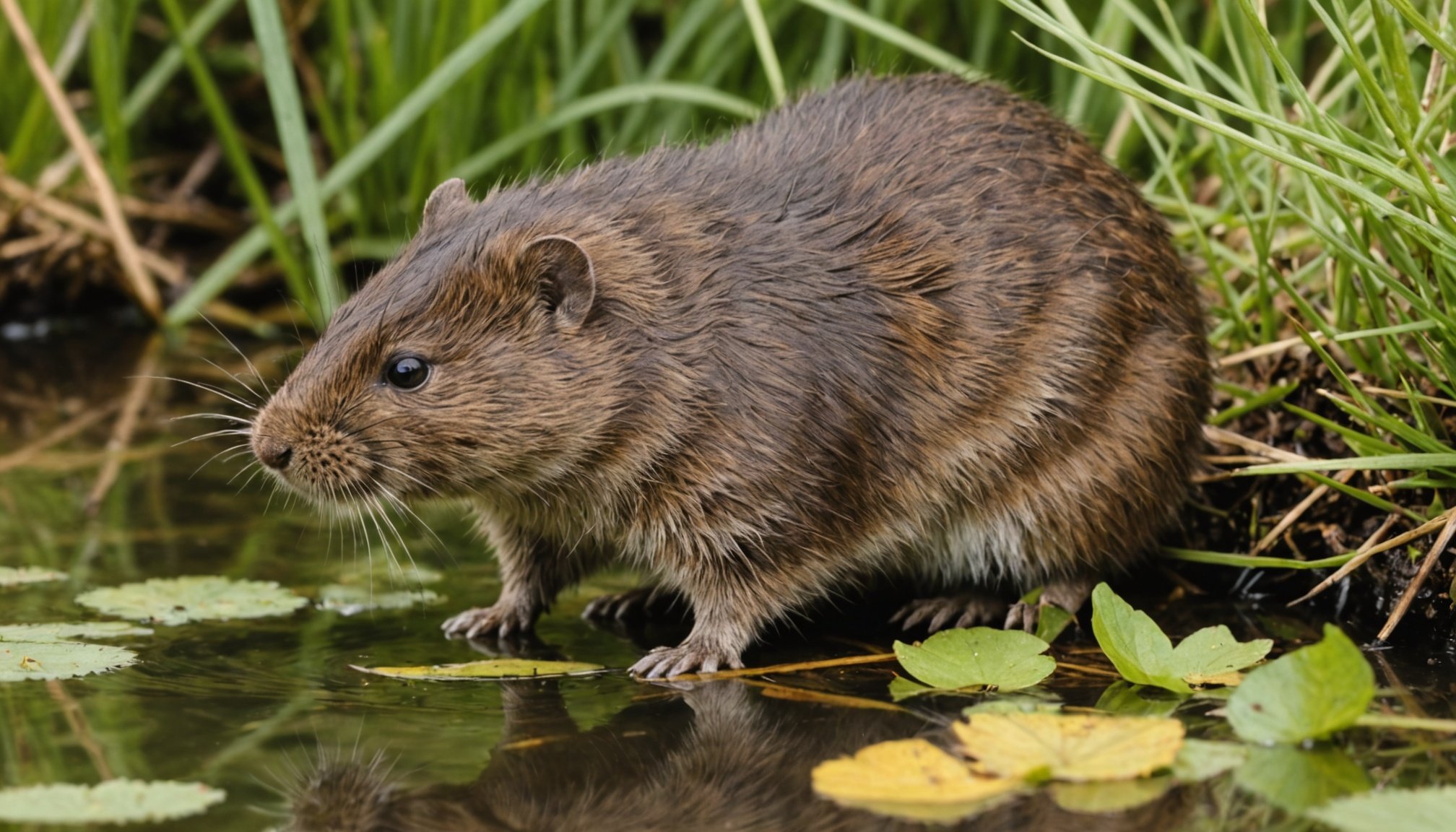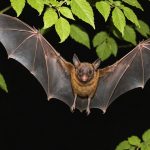Ecological Importance of Water Voles
Understanding the ecological role of water voles unveils their significance in maintaining healthy ecosystems. These charismatic rodents are essential in promoting biodiversity, particularly within wetland environments. By creating intricate burrow systems along riverbanks, water voles enhance soil health, which in turn supports diverse plant species. This interaction is vital as rich plant life fosters a balanced food chain, benefiting myriad creatures, from insects to birds and small mammals.
Water voles also contribute to the dispersal of plant seeds, naturally aiding vegetation growth and ensuring the viability of their habitats. These areas, usually located near water bodies, offer crucial resources for water voles and many other species, creating vibrant ecological communities.
In parallel : Top Tips for Designing Bat-Friendly Habitats in Rural UK: Best Practices Revealed
Wetland habitats are particularly important for water voles, as they require moist soil and easy access to water to thrive. These habitats provide the right conditions for their burrowing and breeding activities. Consequently, the preservation and restoration of wetlands are pivotal for sustaining water vole populations and ensuring the continued ecological benefits they offer.
The water vole’s ecological role underlines the critical need for conserving these habitats, emphasizing a shared responsibility in protecting not only water voles but also the broader ecosystems relying on them.
Additional reading : Exploring the Effects of New UK Wind Farm Developments on Local Bat Populations: A Closer Look at Wildlife Impact
Threats to Water Vole Populations
Water voles face significant challenges due to various environmental threats. The most pressing issue is habitat degradation, primarily caused by habitat loss from urban development and agricultural expansion. As wetlands are drained, the natural environment essential for water voles’ survival diminishes, leading to severe population decline.
Pollution exacerbates the problem, directly impacting the quality of the remaining habitats. Chemical run-off from farms and other pollutants contaminate water sources, posing health risks to water voles and disrupting ecosystems. Furthermore, climate change is altering weather patterns, causing erratic water levels that affect their habitat consistency.
Predation and competition from invasive species also contribute to water vole population decline. The introduction of non-native predators, such as the American mink, has led to increased predation pressures. These species outcompete native fauna, reducing the available resources for water voles.
Collectively, these environmental threats present a formidable challenge. Addressing them requires comprehensive strategies that incorporate habitat protection, pollution control, and the management of invasive species. By doing so, water vole populations can be better safeguarded, contributing to the resilience of broader ecological communities.
Innovative Habitat Restoration Strategies
Implementing innovative habitat restoration strategies is crucial for safeguarding water vole populations. Employing creative restoration techniques helps revitalise ecosystems, ensuring better habitat rejuvenation and sustaining biodiversity.
One key approach involves ecosystem engineering where specialists actively modify landscapes to replicate natural environments. This can include reshaping riverbanks to prevent erosion or creating new wetland areas to cater to water vole habitat requirements. Integrating water flow systems and maintaining soil moisture levels are practical ways to design effective habitats.
Another significant strategy is the reintroduction of native plant species. These plants provide essential food sources and shelter for water voles, alongside supporting entire ecosystems by sustaining other wildlife. Establishing a diverse plant community can improve soil stability and water quality, offering a proper home for voles.
Restoration techniques often involve collaborations between ecologists, local communities, and governmental agencies. This collective effort ensures a comprehensive approach to habitat creation, balancing human activities with environmental preservation.
By applying these innovative methods, restoration projects not only support water vole populations but also enhance overall ecosystem resilience. Such strategies underline the importance of continued research and adaptive management to address the complex challenges facing these environments.
Successful Case Studies in the UK
Successful case studies in water vole conservation offer valuable insights into effective restoration projects. One renowned project is the reintroduction of water voles in the Norfolk Broads. Here, conservationists carefully implemented measures to recreate optimal habitats. Managed water levels, native vegetation planting, and predator controls played pivotal roles. The results were conservation success with a noticeable increase in water vole populations and restored wetland ecosystems.
Another noteworthy example is the conservation initiative along the River Thames. This project focused on mitigating the impacts of urbanisation and enhancing natural habitats through ecosystem engineering. Enabling connected habitats through green corridors encouraged water vole dispersal and increased genetic diversity.
Key outcomes from these projects highlight the necessity of comprehensive planning and sustained efforts. Employing adaptive management strategies and leveraging local knowledge proved beneficial. Lessons learned emphasise the importance of addressing habitat loss and tailoring approaches to local conditions. Moreover, building strong partnerships between stakeholders like governmental bodies, NGOs, and the community was crucial in pooling resources and knowledge.
These successful cases underscore the need for targeted interventions and illustrate that with focused efforts, water vole populations can recover, thereby bolstering broader ecological resilience.
Community Involvement in Conservation Efforts
Engaging local communities is essential for successful water vole conservation. Community engagement brings awareness and enthusiasm to restoration efforts, often through volunteer programs and citizen science. These initiatives not only provide much-needed manpower for conservation, but also foster a deeper connection between people and their local environments.
A vivid example of local conservation is the involvement of volunteers in monitoring water vole populations. By recording sightings and habitat conditions, community members contribute valuable data, complementing scientific research. This practice empowers people to directly participate in the preservation of their neighbourhood ecosystems.
Volunteer programs often collaborate with schools and local organisations, educating participants about ecological roles and the importance of biological diversity. Such programs encourage participants to become stewards of their environment, ensuring long-term conservation efforts are supported by a committed and informed public.
Fostering community support is crucial. Strategies such as community workshops and informational sessions help raise awareness about the importance of water vole habitats. These activities generate enthusiasm for wildlife protection, promoting a sense of collective responsibility for ecological welfare. Ultimately, involved communities play a vital role in bolstering conservation initiatives, providing both social and practical resources needed for success.
Expert Opinions and Guidelines for Restoration
Integrating insights from conservation experts is fundamental to developing effective restoration guidelines for water vole habitats. Experts emphasise the need for tailored approaches, considering habitat requirements specific to each region. Incorporating best practices ensures projects align with the ecological nuances of local environments, essential for restoration success.
One crucial recommendation involves engaging experts in continuous research to understand evolving ecosystem dynamics. Experts advocate for employing adaptive management to modify strategies based on monitoring outcomes, thereby enhancing restoration effectiveness. This framework provides flexibility in responding to environmental changes, ensuring conservation initiatives remain relevant.
Practical guidelines emphasise the reintroduction of native plant species as a cornerstone for revitalising habitats. Experts suggest diversifying vegetation to improve food availability and structural habitat complexity, which are vital for supporting water vole populations and broader biodiversity.
Implementing consistent monitoring is another guideline. This practice allows conservationists to evaluate the efficacy of restoration activities, encouraging data-driven adjustments. Furthermore, fostering partnerships with stakeholders, including local communities and governmental bodies, is highlighted as a best practice, leveraging diverse resources and expertise.
Overall, expert opinions underscore the importance of a multi-faceted approach, combining scientific research, practical application, and community collaboration to achieve robust and sustainable habitat restoration.











